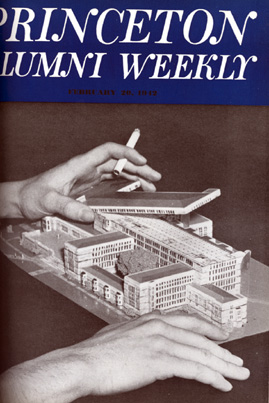|
Web Exclusives:
Under the Ivy March
10, 2004: Take
the gloves off In 1942 the Chapel's soon-to-be campus neighbor, the new library, became the target of fear and scorn, with PAW unintentionally increasing the pitch of the battle. The cover of the February 20, 1942, issue showed a scale model of the proposed building. In the photo, an unidentified hand — holding a cigarette — lifted the roof of the miniature building to reveal a schematic for the floor inside. From the caption, it seems clear that editor Douglas Stuart '35 intended to highlight the intricacy of the remarkable model. He wrote: "This week's cover shows the new library done in miniature from the blueprints. Everything, even including the spaces left for individual desks, is exactly according to scale. The model was constructed by Mr. G. Vinton Duffield, and has attracted much favorable attention in architectural circles." But as so often happens, Stuart's readers took note of — and issue with — everything but the model. Richard Edwards '39 launched the first volley, which he himself compares to war, referring to an earlier PAW letter asking for frankness and truth in the conduct of war. "I make a plea for truth in architecture," Edwards declared. He went on, "I do not propose to tear down immediately the Gothic buildings that already exist in Princeton, though almost anyone who has lived in them will declare that from the point of view of space and fenestration they are the horrors." In conclusion, Edwards wrote, "If we want a modern library with all the space and light and convenience, why box it in with a heavy confinement of pseudo-Gothic stone?" and returned to his war metaphor with the comment, "I note that the model 'has attracted much favorable attention in architectural circles.' There were also many isolationists in America before Pearl Harbor." Edwards's contemporary Swager Sherley '37 had a different, though similarly agitated, perspective. "Every time I view [the library] I will be reminded of either a Government office building here in Washington or of a penal institution with the wings and main body forming cell blocks and the death chamber at the end," he wrote. Naturally, Sherley would prefer "a more Gothic type of building." E. A. Holden '41 took a slightly more light-hearted view, asking, "Who do the hands belong to? What has the cigarette to do with the library? Does it mean that the new building will be fireproof, or that smoking will be permitted? What is hidden under the pulled-back section of the roof and the concealing left hand? Why a large tree to cut off light from what appears to be the main stacks? Last of all, what architectural circles have bestowed favorable attention upon a building which seems to resemble closely a Lynn, Mass., shoe factory?" An exasperated Stuart responded," The hands belong to a young
alumnus. Both the hands and the cigarette are intended to humanize
and give scale to the picture....The large tree, made of green sponge
rubber in the model, may or may not be planted when the building
is finished, but it will not in any event cut off light from the
stacks — all stacks will be lighted by artificial light. It
will not look like a shoe factory."
Jane Martin ’89 is PAW's former editor-in-chief. You can reach her at paw@princeton.edu
|

 There
are a few eternal truths about Princeton, and one is this: "architecture"
is a fighting word. I still chuckle over the arguments that ensued
from Ralph Adams Cram's Gothic design for the University Chapel,
which enraged those hoping for a Colonial building. Cram was moved
to defend himself in a 1928 PAW, writing, "No church conceived
in this [Colonial] mode has acted or could act as a creative spiritual
energy. . . . This was not part of its genre." Gothic, in contrast,
embodied the "great scholastic and spiritual impulse"
that created the storied English halls of learning, and captured,
he hoped, "something of the thrill and the ineffable rapture
of the churches of the Middle Ages."
There
are a few eternal truths about Princeton, and one is this: "architecture"
is a fighting word. I still chuckle over the arguments that ensued
from Ralph Adams Cram's Gothic design for the University Chapel,
which enraged those hoping for a Colonial building. Cram was moved
to defend himself in a 1928 PAW, writing, "No church conceived
in this [Colonial] mode has acted or could act as a creative spiritual
energy. . . . This was not part of its genre." Gothic, in contrast,
embodied the "great scholastic and spiritual impulse"
that created the storied English halls of learning, and captured,
he hoped, "something of the thrill and the ineffable rapture
of the churches of the Middle Ages."